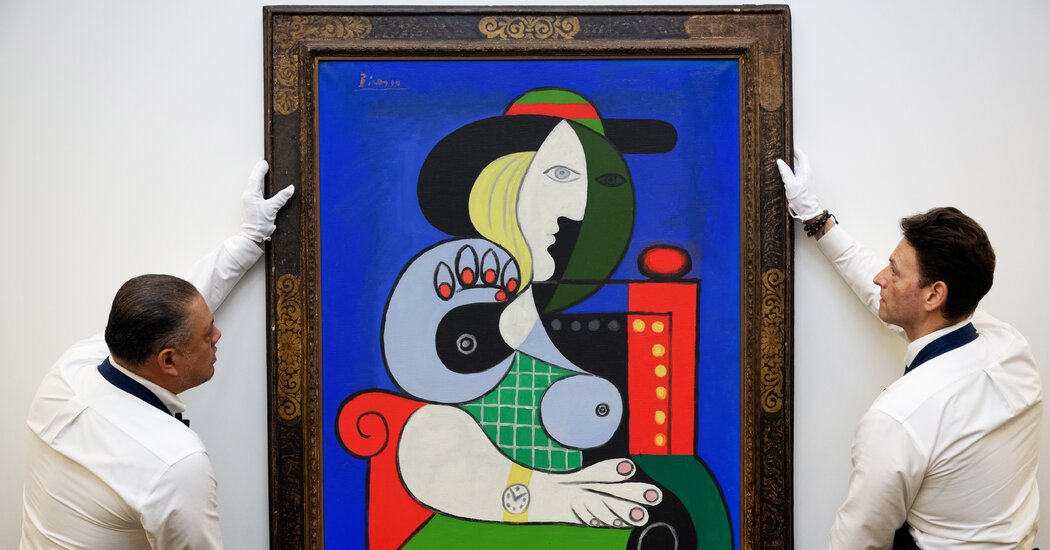[ad_1]
Major auction houses are hedging their bets in the fall season of sales that begins Monday, offering fat guarantees to sellers to secure their works — and pricing some of their top items more conservatively after the spring season demonstrated weakness in the blazing-hot $60 billion art market. And now, sellers are trying to anticipate how the uncertainty of a new war in the Middle East will affect them.
Auctioneers at the three rival companies, Christie’s, Sotheby’s and Phillips, have been digging deeper into private collections for one-off paintings that might spice up their modern and contemporary art sales, given the thinning availability of estates to draw from (typically driven by deaths and divorces).
“We have built the sale in a very old-school way,” said Alex Rotter, chairman of Christie’s departments overseeing 20th- and 21st-century art, who said that his team shopped around individual collectors to acquire works by Joan Mitchell ($25 million to 35 million), Claude Monet ($65 million) and Francis Bacon ($50 million). “We went for paintings that would create the most buzz.”
However, the company lost one of the season’s biggest bounties to rivals at Sotheby’s, which is presenting 31 artworks from the estate of Emily Fisher Landau, a philanthropist who died earlier this year, on the evening of Nov. 8 (there is also a day sale). That collection is estimated at more than $400 million and carries a Sotheby’s house guarantee — a minimum price guaranteed to the family. It contains one of the most expensive Picasso paintings to reach the market, carrying an estimate over $120 million: “Femme à la montre,” a portrait from 1932 of the artist’s mistress, the young Marie-Thérèse Walter. (The current auction high for a Picasso painting, set in 2015: $179.3 million.) Other lots include a 1958 Mark Rothko painting that was completed in preparation for his famous commission at the Four Seasons restaurant in New York’s Seagram Building and a 1964 Ed Ruscha painting whose appearance at auction coincides with a lauded exhibition on the artist at the Museum of Modern Art. Both artworks carry estimates that hover above $30 million.
“We have to go out there and get our supply,” said Brooke Lampley, Sotheby’s chairman and worldwide head of global fine art sales. “Season to season, people are evermore interested in what the big collection of the season will be.”
Sotheby’s and Christie’s expect that the November auction season could bring their companies upward of $1 billion each. But despite the claims of some auctioneers who said there are masterpieces around every corner, art advisers and market experts have noted the broader market’s lack of stellar inventory and buyer focus.
“We are experiencing a recalibration in the market after the comeback that we saw in 2021 reached its peak last fall,” said Drew Watson, head of art services for Bank of America’s private bank, who was referring to the $1.5 billion sale of artworks collected by Paul G. Allen, the Microsoft co-founder. “We were already seeing signs of the market softening at this time a year ago, if you looked at day and evening sales. There was less depth of bidding.”
During the spring auction season in May, three paintings by Jasper Johns offered at Christie’s failed to reach their low estimate. Paintings by other artists were withdrawn before the auctions started, signaling a lack of confidence in the market or inflated prices. Celebrity auctions have helped attract crowds in the meantime, with consignments from Barbara Walters and Freddie Mercury drawing collectors willing to spend thousands of dollars on mementos.
Watson said there was a noticeable uptick in guarantees from auction houses and third parties, which provide consignors with a confirmed minimum sales price.
“It has become an increasingly important tool for auction houses to coax high-value properties into the market,” Watson said. “For buyers, it is also an important signal of confidence. It gives potential bidders something to bid against. And it only takes two bidders to create an auction.”
Robert Manley, deputy chairman at Phillips, said that his auction house has guaranteed the 30 artworks from the Triton Collection Foundation in the Netherlands, which includes pieces by Fernand Léger and Pablo Picasso. The entire collection, to be auctioned Nov. 14, has a high estimate of $100 million.
In another noticeable downshift, Manley said that rampant speculation in the ultracontemporary market for young artists born since 1975 — many without a museum provenance — had decreased.
“I hate to use the word sanity, but people are more measured,” he said. “It is still not unusual for young artists to rocket up to $200,000 or $300,000. But over the last few years, artists were quickly going to $800,000 and $1 million.”
What is behind this more cautious market? Magnus Resch, an art market economist, said that higher interest rates and the global uncertainty of two major wars, in Europe and the Middle East, could dampen next week’s sales.
“People are just less active in times like these,” Resch said. “There is a large group of buyers who have Israeli connections. It is understandable that buying luxury items is not on their minds right now.”
For major collections, auction houses often set their estimates about six months in advance, although regular evening sales have more flexibility; nowadays, they are finalized a few weeks ahead of the sale. But the economic volatility of global conflicts might widen the gap between expectations and reality, some auctioneers fear.
“I am not painting you an elephant in every corner,” said Rotter, the Christie’s executive. “To say anything that happened this year will have no impact would be irresponsible.”
[ad_2]
